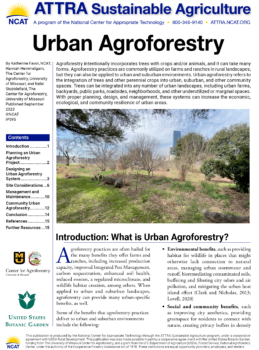Urban Agroforestry
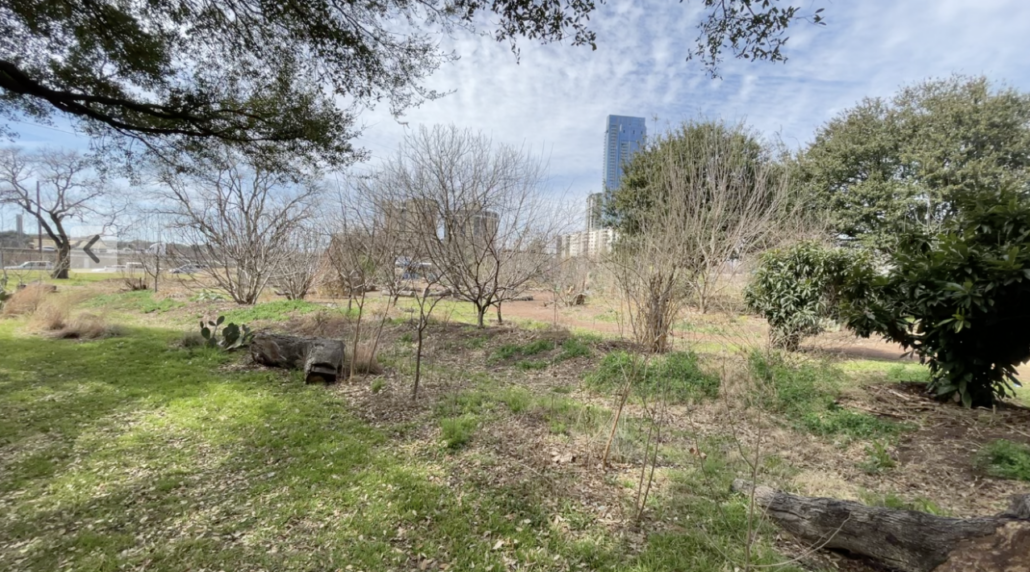
By Katherine Favor, NCAT Agroforestry Specialist; Hannah Hemmelgarn, Assistant Program Director, The Center for Agroforestry, University of Missouri School of Natural Resources; and Kelsi Stubblefield, Outreach and Communications Coordinator, The Center for Agroforestry, University of Missouri
Abstract
Agroforestry intentionally incorporates trees with crops and/or animals, and it can take many forms. Agroforestry practices are commonly utilized on farms and ranches in rural landscapes, but they can also be applied to urban and suburban environments. Urban agroforestry refers to the integration of trees and other perennial crops into urban, suburban, and other community spaces. Trees can be integrated into any number of urban landscapes, including urban farms, backyards, public parks, roadsides, neighborhoods, and other underutilized or marginal spaces. With proper planning, design, and management, these systems can increase the economic, ecological, and community resilience of urban areas.
Contents
Introduction
Planning an Urban Agroforestry Project
Designing an Urban Agroforestry System
Site Considerations
Management and Maintenance
Community Urban Agroforestry
Conclusion
References
Further Resources
Introduction: What is Urban Agroforestry?
Agroforestry practices are often hailed for the many benefits they offer farms and ranches, including increased production capacity, improved Integrated Pest Management, carbon sequestration, enhanced soil health, reduced erosion, a regulated microclimate, and wildlife habitat creation, among others. When applied to urban and suburban landscapes, agroforestry can provide many urban-specific benefits as well.
Some of the benefits that agroforestry practices deliver to urban and suburban environments include the following:
Environmental benefits, such as providing habitat for wildlife in places that might otherwise lack connection to natural areas, managing urban stormwater and runoff, bioremediating contaminated soils, buffering and filtering city odors and air pollution, and mitigating the urban heat island effect (Clark and Nicholas, 2013; Lovell, 2020);
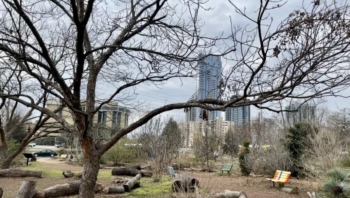
The Festival Beach Food Forest in Austin, Texas, is an example of agroforestry in the middle of a bustling metropolis. Photo: Katherine Favor
Social and community benefits, such as improving city aesthetics, providing greenspace for residents to connect with nature, creating privacy buffers in densely populated spaces, increasing food security, reducing the distance produce travels to reach consumers, and serving as a place for the community to gather and nurture social connections (Lovell, 2010).
Urban agroforestry can take many forms, but like any agroforestry system, urban agroforestry systems must be designed intentionally to account for the integration of diverse elements, must actively manage the interspecific interactions between the components of the system, and must be managed intensively. With proper planning, design, maintenance, and decision-making, urban agroforestry projects can improve the resilience of cities and the wider environment around them.
Planning an Urban Agroforestry Project
Evaluating Goals, Resources, and Growing Context
Trees can be integrated into any number of spaces in an urban landscape, from backyards to public parks, roadsides, neighborhoods, urban farms, and more. The way trees are integrated into these landscapes is highly flexible and depends on many factors, including the available resources, site-specific growing context, and overall goals of the producers and/or community members involved.
When inventorying available resources, consider the kinds of financial resources, land, utilities, labor, markets, equipment, certifications, knowledge, talents, skills, partnerships, and community assets that can be accessed. Taking into account all of these resources can help with planning an urban agroforestry project that is not only feasible, but also sustainable and economically viable in the long run.
Growing context refers to the unique environmental, social, and economic conditions that will impact a project, including the climate, topography, USDA Plant Hardiness Zone, soil type, community, historic land use of the site, local municipal regulations, and the pests, weeds, native vegetation, and wildlife in the area. Evaluating your growing context can help you identify opportunities, as well as challenges and barriers that may affect your plans. It can also help you design a project that is responsive to local needs and to the unique environmental conditions around the community. Evaluating goals is at the heart of any sustainable project, and identifying them upfront will help keep a project on track and aligned with all participants’ visions and values. Trees are a tool that can help cities remediate urban-specific problems and resource concerns, and identifying these site-specific concerns when evaluating goals can help inform how trees are utilized in a landscape.
Goals of an urban agroforestry project may include these, among others:
- Producing a wide variety of locally grown food or medicine to combat food insecurity and address health and nutrition needs
- Producing the maximum amount of food possible within a small square footage
- Beautifying a city, neighborhood, or residence
- Providing green space for community members to connect with nature
- Facilitating social connections between community members and neighbors
- Providing a space for community members, children, and others to learn about plants, ecosystems, and how to grow their own food
- Generating value (as money or trade) for yourself, your community, or a cause
- Creating jobs in your community
- Reducing the heat island effect that commonly occurs in urban areas
- Providing habitat for wildlife
- Attracting pollinators and beneficial insects to a farm or garden for increased Integrated Pest Management
- Managing urban stormwater runoff in order to prevent erosion and contamination
- Protecting crops from wind in order to increase the productivity of an urban farm
- Creating privacy barriers between neighbors, if privacy is desired
- Buffering and filtering air pollution and odors
- Remediating contaminated soil
- Building nutrient-dense, healthy soil
- Producing raw materials for crafts or decorations
Overall, evaluating goals, resources, and growing context will help ensure that an urban agroforestry project is addressing identified needs while remaining economically, environmentally, and socially sustainable over time. Your particular approach to selecting and integrating trees into a local landscape will depend on all of these factors.
Designing an Urban Agroforestry System
Tree Arrangement and Layout
In temperate climates, there are six common agroforestry practices, or approaches to integrating trees in an agroforestry system, including: silvopasture, alley cropping, windbreaks, riparian forest buffers, forest farming, and forest gardening (USDA National Agroforestry Center, 2022; The Center for Agroforestry, 2023). Depending on the goals of your site and on what challenges you want to address, you may consider drawing upon the design principles of one or more of these agroforestry practices when integrating trees into an urban agroforestry project.
If your goal is to grow a wide variety of food, medicinal plants, and other useful products in a small space, consider arranging trees and plants in the form of a forest garden or food forest. Forest gardens are agroforestry systems that mimic the structure and composition of early-succession forests and are composed of as many as eight vertical layers of edible, medicinal, ornamental, habitat-providing, or other useful plants and fungi. Layers typically consist of an overstory tree layer of tall trees, an understory layer of medium-sized trees, a shrub layer, an herbaceous crop layer, a groundcover layer, a vine layer, a root crop layer, and a fungi layer consisting of mushrooms and other mycelial life. Forest gardens serve to produce a wide variety of food in a small space and can help contribute to the nutritional needs of a family or a community. The diversity inherent in forest gardens results in resilient systems that tend to rely less on external inputs such as fertilizers and pesticides. In urban spaces, it is common to see community forest gardens that are maintained and used by the public, and they can also serve as places for community members to connect with nature and each other. You can read more about urban forest gardens in the Forest Gardens Technical Guide.

The Festival Beach Food Forest in Austin, Texas, produces a wide variety of food and medicinal plants in a small space, granting community members access to free local, fresh, and nutrient-dense food that can supplement their diets. Photo: Katherine Favor
If your goal is to harvest food from existing urban forested spaces, consider drawing from the design principles of forest farming. Forest farming refers to the practice of cultivating a layer of high-value, shade-tolerant or shade-obligate (requiring shade) understory crops under the canopy of an overstory layer of trees in an established forest or orchard. In urban spaces, this can take the form of growing or stewarding shade-loving crops, such as mushrooms, leafy greens, brassicas, herbs, leeks and onions, and other native edible or medicinal plants under the canopy of native trees on public park land or in wooded private or shared residential areas (McLain et al., 2017). Individuals or municipalities interested in preserving urban canopy cover while also producing a harvest and conserving forest botanical species populations might consider this combined tree and “non-timber forest product” crop arrangement.
If your goal is to maximize crop production in a small space, consider drawing from the design principles of alley cropping. Alley cropping refers to the practice of planting understory crops between rows of trees or shrubs. The overall yield of alley cropping systems can be higher than that of monoculture crops (Seserman et al., 2018), which can be especially beneficial for urban farms with small acreage. An example of an urban alley cropping system is Coastal Roots Farm in San Diego, California. This system consists of rows of pomegranates, elderberries, and fig trees, with rows of vegetables in between. Because this system is maximizing vertical space, Coastal Roots Farm is able to produce more than it would if it were simply growing vegetables on its land. Additionally, the shade provided by trees reduces heat stress on crops below, allowing Coastal Roots Farm to extend its harvest. Today, Coastal Roots Farm harvests 80,000 pounds of food per year on just over eight acres of land in the middle of a city, largely thanks to the high productivity of its alley cropping design.

Coastal Roots Farm in San Diego, California, is able to produce a large volume of vegetables and fruit in a small urban space, thanks to its alley cropping system. See ATTRA’s Community Forest Gardens: Case Studies for more details on this operation. Photo: Katherine Favor
If your goal is to rely on fewer external inputs, maximize your use of space, or diversify your farm’s revenue streams with livestock, consider drawing from the design principles of silvopasture. Silvopasture refers to trees, pasture, and livestock integrated into a single intensively managed system. In urban areas, small animals such as chickens, geese, rabbits, or even small ruminants can be integrated into cropping systems to provide nutrients to the soil, to help control pests and weeds, and to help shallowly till beds and prepare them for planting. These animals can also produce eggs, meat, or wool, providing urban farms with additional resources and/or diversified revenue streams. One common approach to urban silvopasture is rotating chickens or other poultry through the understory of urban orchards or within alley cropping systems to seasonally fertilize with their manure, reduce pest pressure, and recycle fallen fruits. When integrating any livestock, check with your local NCAT, USDA, or Extension personnel on how to adhere to food safety standards and avoid direct contact between manure and food for human consumption. It’s also important to check with your local municipality to see which and how many animals are permitted under your area’s zoning regulations.
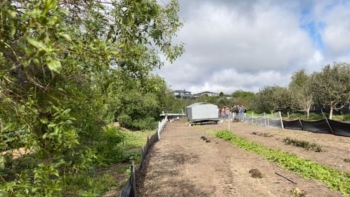
Coastal Roots Farm in San Diego, California, plants vegetables in between rows of elderberry, fig, pomegranate, and pineapple guava trees, and incorporates chickens at certain times of the year to add fertility to the soil and to provide the farm with eggs to sell. Photo: Katherine Favor
If your goals are to manage urban stormwater runoff, protect bodies of water, and improve environmental conservation efforts, consider drawing from the design principles of conservation buffers or riparian forest buffers. Conservation buffers are bands of trees, shrubs, forbs, and grasses, and they can provide many environmental benefits to cities, such as managing stormwater runoff, stabilizing streambanks, providing habitat for wildlife, and, in some cases, reducing the impact of flooding. The complex web of roots in conservation buffers helps keep soil in place, increases soil water-holding capacity, reduces runoff, and filters out toxic chemicals from infiltrated water before it reaches rivers and streams.
In cities, conservation buffers can be planted strategically along roadsides and other locations to prevent polluted stormwater from making its way into natural bodies of water or onto urban farms. They can also be planted alongside bodies of water or in floodplains to stabilize the soil, promote water infiltration, and reduce overland flow of water — all of which can contribute to reduced flooding. When designing conservation buffers in cities, municipal engineers and ecologists typically play a role in deciding where trees would best be integrated on the landscape to satisfy multiple goals. The City of Austin, Texas, is a great example of a municipal government that is utilizing trees in strategic areas to restore a floodplain that was previously a residential area. You can read more about the City of Austin’s efforts in the ATTRA publication Urban Agroforestry Case Study: Utilizing Agroforestry in Floodplain Restoration Projects.
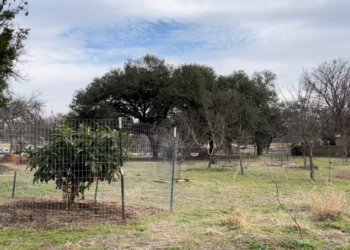
The City of Austin, Texas, is using urban agroforestry to restore a floodplain after a buyout project in which residential housing was torn down in a flood-prone area. Photo: Katherine Favor
If your goal is to protect crops from wind damage, provide privacy to humans, improve air quality, reduce urban odors, or provide habitat for wildlife, consider drawing from the design principles of windbreaks. Windbreaks or hedgerows are rows of trees planted along the edges of fields or in other strategic locations in a linear pattern. In cities, they can be used to slow wind flow, reduce wind erosion, buffer and filter odors, provide privacy, provide habitat for wildlife, and attract pollinators. For maximum benefits, plant one or more rows of trees and/or shrubs, with ideally at least one row of evergreen trees for year-round protection, and with deciduous trees and shrubs for structural and biological diversity. Planting windbreaks with species that flower at different times is a good way to attract pollinators and wildlife to your urban agroforestry project throughout the growing season.

Garcia Street Urban Farm in San Antonio, Texas, is utilizing windbreaks on its urban farm to protect crops from harsh winds and cold fronts, to attract beneficial insects and pollinators to the farm, and also to provide habitat for wildlife. Photo: Katherine Favor
If your goal is to improve city aesthetics and increase residents’ access to nature, any arrangement of trees will satisfy your goals, if the space is accessible to the community and relevant to their needs and preferences!
Species Selection
Once you have decided how to arrange trees on an urban landscape to satisfy your goals, species selection can take place. Many factors will contribute to which species you choose to plant. No matter what, it is important to choose plants that are adapted to your USDA Plant Hardiness Zone and that grow well in your area. Native and naturalized plants are ideal because of their adaptive resilience, their ability to survive with relatively few inputs, and their ability to provide habitat to native fauna. To determine which trees and crops are ideal for production in your area, consult your local Cooperative Extension Service and other local professionals. To determine which trees are ideal for conservation purposes in your area, consult your local Natural Resources Conservation Service (NRCS) office. For specific guidelines on species selections for urban forest gardens in particular, the Forest Gardens Technical Guide provides detailed information.
Site Considerations
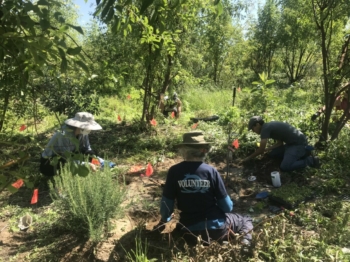
Volunteers enjoying a day in the Coastal Roots Farm Food Forest. Photo: Katherine Favor
Urban agroforestry projects can be implemented on land that is public, privately owned, or leased. Regardless of ownership structure, it is important to review city zoning designations and ensure that the site is provisioned to allow the project. Some land in urban areas may be zoned for agricultural production; however, even when urban land parcels are not zoned as agricultural, many cities have land development regulations with provisions for urban agricultural activities. If agriculture is not explicitly named as a legal use of land in municipal code, it may still be possible to apply for a special-use permit or to work with the local government to change or add to the existing code. Many urban farms have been able to successfully alter city code to allow produce to be grown and sold on land that is not explicitly zoned as agricultural. Note, however, that this process can involve significant time and effort.
Private Land
Urban agriculture projects can be implemented on private land as long as the site is approved for agricultural use by the city or county. There are several financial tax incentives for landowners wishing to implement urban agroforestry projects. Some counties offer property tax incentives for landowners who use or lease their vacant or undeveloped property for agriculture production, often with a minimum acreage size. Some states offer “current use” value assessments of land, which can result in lower tax rates and sometimes direct tax credits for agricultural uses. Property owners interested in using or leasing their vacant lots for agriculture can contact their state and county to see if they qualify for these tax-reduction incentives. Unfortunately, most backyards do not qualify for these tax incentives, and these tax incentives are not available in every city or state.
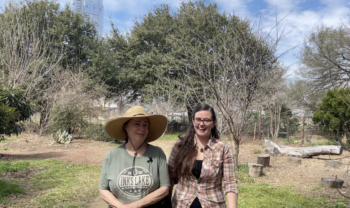
The Festival Beach Food Forest in Austin, Texas, is an example of a food forest on public park land. Festival Beach Food Forest went through two full years of planning with community members, local organizations, and other stakeholders before it was able to develop a plan for a food forest that was feasible, safe, and reflective of the community’s vision and values. While planning can take time, it is a crucial step to ensure that your project remains sustainable for years to come. Photo: Katherine Favor
Public Land
It is also possible to start an urban agroforestry operation on public land. This is a significant undertaking but can result in a wonderful asset for the community to enjoy. Cities and counties themselves can implement urban agroforestry on their public lands, or nonprofits, community associations, and individuals can partner with or lease city or county land. It is important to involve community members as much as possible when planning an urban agroforestry project on public land, so that the space is reflective of what the community wants to see. Once a plan is in place, implementing a public urban agroforestry project requires working with the local municipality, oftentimes the Parks and Recreation Department, to discuss steps, create agreements, and establish a maintenance plan. It is important to create clear agreements around insurance and liability concerns, utility usage, permitted structures, and maintenance. It is also important to discuss where the resources for establishment and maintenance will come from. There are sometimes resources that municipalities can contribute for establishment and maintenance, such as seeds, tree saplings, irrigation, fencing, mulch, pruning of some trees, and/or regular mowing of grassy areas. Other resources, such as labor to maintain a site or additional inputs, may need to be sourced from individuals, nonprofits, community groups, or donor funding. Every municipality will have different resources that they can offer, so it is important to work with the local city or county government and to establish clear agreements when starting an urban agroforestry project on public land.
Ordinances and Regulations
Municipal zoning ordinances dictate whether agricultural activities are allowed on a given site, but they also can regulate what kinds of infrastructure can be built on urban farms. For example, in areas that are not zoned as residential, there may be limitations around having restrooms, greenhouses, sheds, and other structures on a site. This is usually a city’s attempt to discourage people from living in areas that are not zoned as residential, but these regulations can prove challenging for urban agroforestry operations. If you find yourself confronting regulations about this type of infrastructure on an urban agroforestry site, you may be able to work with your municipality to alter or add to zoning ordinances.
Beyond zoning ordinances, there may be additional city ordinances to be aware of, as well. Some cities have regulations surrounding how urban agriculture sites should look aesthetically. Regulations may limit how weeds are managed, how tools are stored, how many livestock animals or chickens are permitted on site, and how tidy the space must appear from the street. For example, urban farms may be prohibited from having visible mulch piles, from keeping livestock, or from leaving tractors outside. There may also be regulations about how tall hoophouses can be, or about what materials structures can be made of. It is important to work with your municipality before building or planting anything for an urban agroforestry project, in order to ensure that it can operate legally and sustainably.
Locating and Accessing Utilities
Urban areas have vast webs of utility infrastructure, both above and below ground, and many of these utilities are hidden from sight. Before establishing an urban agroforestry system, it is important to locate below- and above-ground utilities, in order to minimize any potential risks associated with them. One tool commonly utilized is the 811 national “call before you dig” phone number, which can determine if there are below-ground utilities such as gas lines, sewer lines, water pipes, fiber optic cables, or other infrastructure under the intended planting zone. Upon request, 811 can send a specialist to mark the location of buried utilities on an intended site, so that project participants can avoid digging in those areas. Above-ground utilities such as power and telephone lines are also important to be aware of. It is important to not plant trees in close proximity to utilities, sidewalks, buildings, or homes, as trees could one day grow to obstruct or interfere with these structures.

An example of some of the potentially dangerous hidden utilities to look out for before beginning an urban agroforestry project. Photo: Katherine Favor
Accessing utilities such as water, electricity, sewage, and gas is also an important undertaking. Connecting to the city infrastructure that provides these resources can be expensive, depending on how the site is zoned. For example, connecting irrigation pipes to city water and installing meters on non-residential properties can cost up to hundreds of thousands of dollars. In cases such as these, it may be possible to collaborate with the local municipality to obtain a special-use permit in order to bypass high costs when connecting to city utilities. Alternatively, urban agroforestry sites may be able to connect with the established utilities of other nearby areas, or generate some utilities themselves through appropriate technologies such as rainwater catchment systems, solar panels, and more.
Dealing with Contamination and Debris
Urban areas often contend with unique contamination challenges, such as accumulation of trash, deposits of debris from previous development, soil contamination from heavy metals and hydrocarbons, runoff from lawn herbicides, polluted stormwater runoff, polluted air from nearby roads and factories, and more. Luckily, there are many strategies for dealing with contamination problems such as these.
Before beginning an urban agroforestry project, it is important to ensure that the site’s soil is not contaminated, as contaminants may be taken up by plants and can end up in produce or can be tracked inside homes on clothing and shoes. It is recommended to conduct soil tests for, at minimum, heavy metals such as arsenic, barium, cadmium, chromium, lead, and nickel. For production purposes, it is a good idea to conduct a baseline soil health test for nutrients, as well. For more information on soil testing, visit the ATTRA publication Soil Health Indicators and Tests.
If test results indicate that soil is contaminated, it may be possible to perform a “Phase I Environmental Site Assessment” with the help of the Environmental Protection Agency (EPA). During this site assessment, the EPA will review records to determine the history of the site and assess the likelihood of significant contamination. If contamination is likely, a “Phase II Environmental Site Assessment” will be conducted, in which soil and/or groundwater is further tested for lead, other heavy metals, and hydrocarbons. If the results of these soil and water tests indicate contamination, the site might qualify as a “brownfield,” defined by the EPA as a property that has the presence of hazardous substances or contaminants. Brownfield sites are eligible to receive “cleanup grants” to fund remediation projects led by environmental professionals. Depending on the severity of contamination, remediation might involve removal of debris, “capping” by creating a barrier over the layer of soil that is contaminated, bioremediation with microbes and fungi, phytoremediation with plants, or lead and asbestos abatement (United States EPA, 2019). Phytoremediation is often enough to clean up contaminants on urban sites; perennials, such as poplars and willows, and annual crops, such as hemp, have been effective at taking up toxic compounds and may be suitable choices for contaminated urban environments in the proper climates. By growing these crops on the site for several years before planting edible crops, many contaminants can be removed from the soil.
Most soils will be considered safe for producing edible crops after a remediation process is undertaken. At particularly damaged sites, however, even after a remediation process there may still be risk of contaminants in the soil. In cases such as this, one option post-remediation is to plant the site with mostly woody perennials as opposed to annuals, as tree and shrub species accumulate fewer heavy metals and hydrocarbons in their fruits and nuts, compared to annuals (Romanova and Lovell, 2021). For example, perennial crops such as apples accumulate fewer contaminants than do annual crops such as strawberries, because the contaminants tend to stay lodged in the woody biomass of trees and shrubs as opposed to traveling all the way to flowers and fruit. Alternatively, instead of avoiding annual crops completely, another option is to grow annual crops off of the ground, such as in raised-bed gardens with clean imported soil, or in logs inoculated with mushroom spawn.
Although many contamination issues in urban growing spaces require serious intervention, some pollution issues, such as herbicide contamination from nearby lawns, stormwater runoff, and unpleasant odors from car exhaust, can largely be prevented by reducing the amount of polluted water and air arriving at a site. This can be done through creating barriers, such as hedgerow or windbreak plantings around the edges of the property. Foliage from trees and shrubs can help buffer odors and air pollution, while tree and grass roots can reduce runoff and filter out toxins in water before they reach the site. Limiting your own use of chemical fertilizers and herbicides on your site can prevent future contamination, as well.
Insurance, Liability, and Certification
Registering, certifying, and insuring urban agroforestry operations can help secure the ability to produce and distribute crops legally, as well as to safely host visitors at the site.
If an urban agroforestry operation is commercial in nature with plans to sell produce, it may be required to register with the local department of agriculture and to obtain a tax certificate from the local Office of the City Treasurer. While a tax certificate is typically required, there may be exemptions for small-scale agriculture operations. It’s a good idea to consult with these entities about this and other local regulations as well, such as where an operation is permitted to sell. For example, many counties only permit farmstand sales in commercial and industrial zones, but it may be possible to sell in residential zones under certain conditions or on certain days of the week. If produce from an urban agroforestry operation is intended to be sold at certified farmers markets, it may be necessary to become a Certified Producer by obtaining a Certified Producer Certificate (CPC) issued by the local County Agricultural Commissioner. Contact your local agricultural commissioner’s office to initiate these processes. There are federal programs that also require registration in order to participate in them. If you plan on participating in federal programs such as the Natural Resources Conservation Service’s financial assistance and cost-share programs, you will need to register with the USDA Farm Service Agency (FSA).
Insurance is an important consideration for an urban agroforestry project, as well. If an urban agroforestry project is commercial in nature, or if it will be open to members of the public, it is important to obtain the proper insurance policy to protect the operation. If an operation is for personal use on private property, however, insurance is not needed.
Management and Maintenance
No matter where an urban agroforestry project is located, how trees are arranged to satisfy goals, or what trees and crops are chosen to plant, there are some general considerations for maintenance that are important to keep in mind in urban areas, including weed management, pest management, irrigation, equipment, and tools.
Weed Management
Weeds are as much of a problem in urban spaces as they are in rural farming contexts. In urban areas in particular, ornamental grasses can be a major weed coming from lawns in surrounding residential areas. Because grasses can self-propagate not only through seed production, but also through stolons and rhizomes, they can be difficult to control. In urban areas, land managers often avoid using conventional herbicides to control weeds, to reduce the potential for these chemicals coming into contact with neighbors and community members who interact with the space. Rather than using chemicals, grasses or any other weeds can be successfully managed organically through strategies such as these:
Occultation, in which dark plastic tarps or landscape fabric are laid down over weeds for extended periods of time.
Solarization and biosolarization, in which clear plastic is sealed over weeds for two weeks to one month.
Tillage, in which weed roots and rhizomes are broken up and killed. Even in small spaces, this can be done with the proper tools or by chickens.
Mulching, in which wood chips, straw, grass clippings, or other bulky organic matter are layered on top of soil in a 2-inch to 6-inch layer.
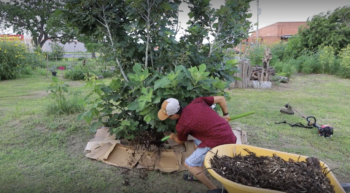
Keepers of the Garden is an urban food forest in Corpus Christi, Texas, that utilizes a combination of sheet mulching and occultation to manage bermuda grass and other weeds. Photo: Katherine Favor
Sheet mulching, in which cardboard and mulch are layered on top of one another to prevent light from reaching weeds. Mulch can be obtained for free from tree trimming services in many urban areas, and cardboard can also be obtained for free from recycling centers, shipping centers, or neighbors themselves.
Mowing with lawn mowers, weed whackers, and other small pieces of equipment.
Grazing by animals such as chickens, babydoll sheep, or pigs, if allowed by city ordinances.
Cover cropping with groundcover that smothers weeds. In forest gardens, edible cover crops such as winter peas, oregano, mint, etc. can be used both as weed control and to produce food.
Pest Management
Research has shown that urban farms with trees and shrubs integrated into the farmscape experience less pest damage than do urban farms without perennial components (Egerer et al., 2020). Still, urban agroforestry systems, like any farm, will contend with some pest pressure. In urban areas where neighboring properties are close, it is extremely important to follow Integrated Pest Management guidelines and to use pesticides only as a last resort, after first managing pests through preventative measures. If pesticide use is determined to be necessary, many urban agroforestry land managers opt for organic pesticides. It is also important to spray with backpack sprayers with the correct nozzle size, so that application is targeted and pesticides do not drift to nearby areas.
Urban wildlife can be major pests in urban agroforestry systems. Deer, birds, squirrels, gophers, moles, voles, raccoons, rabbits, and even cats and dogs are common in urban areas and can cause significant damage to crops. The best way to avoid damage from urban wildlife is to prevent their access. Deer can be deterred through the use of fences, although some urban areas have height restrictions for fencing, so it’s important to check local regulations before installing a fence. Gophers can be deterred by planting trees and shrubs into gopher baskets, and plants can be protected from birds and rabbits by putting down bird netting or floating row cover cloth. Because urban agroforestry sites are often used by people on a regular basis, these preventative measures are safer than other pest management methods like mouse traps, gopher traps, poison, and pesticides. Since these pest control methods are discouraged by practitioners in urban agroforestry systems, most practitioners embark on their urban agroforestry projects expecting that some yield losses from urban wildlife will occur.
Alternatively, urban agroforestry can be used to intentionally attract and support urban wildlife. Trees in urban agroforestry systems can serve as wildlife corridors: plantings of habitat that serve as passageways for wildlife to move across landscapes that are urbanized and fragmented. Even a small amount of habitat can make a significant difference for supporting wildlife. Coastal Roots Farm, an urban agroforestry farm in Encinitas, California, is one example of how beneficial even a small acreage of trees can be for supporting wildlife. Its 8-acre alley cropping system located in the middle of a bustling suburb of San Diego was found to host members of a threatened bird species, the California Gnatcatcher, along with dozens of other bird species.
Irrigation
Irrigation will be necessary to establish trees successfully in most areas of the United States. In areas with high precipitation, irrigation may only be needed for the first few years, but in other areas, it may be necessary on a permanent basis. The design of the irrigation system will vary depending on the design of the urban agroforestry system, and may consist of drip irrigation, microsprinklers, or earthworks to capture and store water. Consult the Forest Gardens Technical Guide for specifics on how to design irrigation and water catchment systems for forest gardens in particular.
Many urban agroforestry projects are tied to municipal water systems. When planning an urban agroforestry project, it is important to check with your municipality for information about permits, rates, and restrictions, especially during periods of drought. Permits for water use can be expensive, but it may be possible to work with your local government to obtain special use permits to avoid some of those costs.
Equipment and Tools
Because urban agroforestry systems typically occupy a smaller amount of space than rural production farms, they often rely on small equipment and hand labor for maintenance. Some common tools and equipment for use in urban agroforestry systems are listed in Table 1.
| Table 1. Small Tools and Equipment | |||||
| Cultivation and Soil Preparation | Seeding and Transplanting | Pest Control | Weed Management | Pruning | Harvest |
| Walk-behind tractors | Spin seeder broadcasters | Backpack sprayers | Hoes (collinear, swan-neck, stirrup, diamond, etc.) | Chainsaws | Picking buckets |
| Digging forks and broadforks (U-bars) | Pinpoint seeders | Gopher baskets | Walk-behind tractors | Pruning saws | Collapsible utility wagons |
| D-handle spades | Jab-type seeders | Fencing | Walk-behind mowers | Handheld loppers | Telescoping fruit harvester picking baskets |
| Garden rakes | Trowels | Bird netting | Flame weeders | Handheld pruners | Nut wizards |
| Dribblers | Traps | ||||
| Shovels | |||||
For more information about tools for urban agroforestry systems and other small production systems, refer to the ATTRA publication Equipment and Tools for Small-Scale Intensive Crop Production.
Community Urban Agroforestry
Urban agroforestry can be incorporated into various community sites such as churchyards, neighborhood parks, schools, roadsides, underutilized lots, and other shared-use spaces, providing numerous social benefits to the community (Turner-Skoff and Cavender, 2019). These types of shared-use systems can promote food security not only by supplementing access to fresh food and medicinal plants, which is especially important in urban areas where food deserts are more common, but also by providing an educational context in which people can learn how to grow their own food in their own backyards and patios. As multifunctional green spaces, urban agroforestry sites can provide a respite from the hustle and bustle of city life, offering a space for people to freely connect with nature within developed landscapes where they might not otherwise be able to (Bukowski et al., 2018). While community members gather alongside each other to work, learn, and harvest, urban agroforestry sites can also be spaces for fostering social connections between neighbors and friends. These emotional benefits translate into concrete health benefits as well; interacting with trees has been shown to improve health quantifiably by reducing stress, fostering an increased sense of wellbeing, and even lowering blood pressure (Turner-Skoff and Cavender, 2019). Dense plantings of trees help reduce the urban heat island effect, helping to cool the landscape during the heat of summer and reduce the rate of heatstroke. Trees can also accumulate particulate matter from pollution, helping to clean the air and reduce city odors. These are just some of the many ways that trees improve human health and wellbeing in a community context.
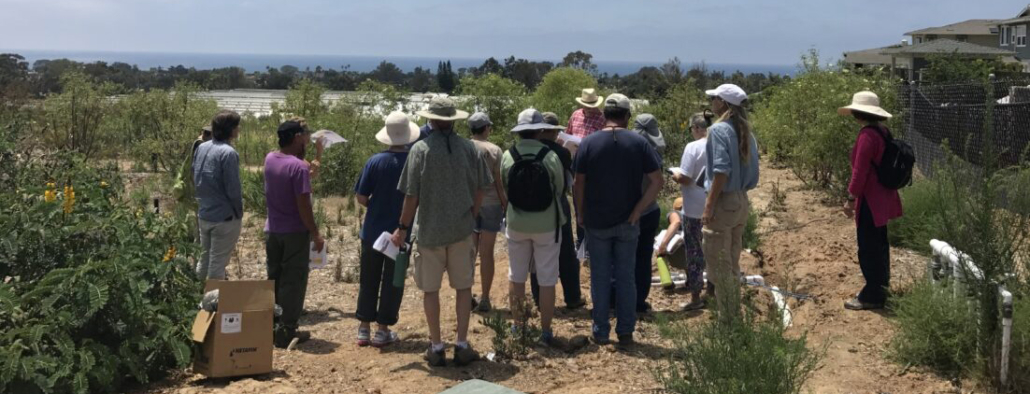
An educational tour at Coastal Roots Farm’s food forest in San Diego, California. Photo: Katherine Favor
Group Decision Making
The decision-making structure of community urban agroforestry sites will be influenced by the people who will be interacting with the space. This may be limited to the people within a neighborhood, or as extensive as a school district, a church, or the public as a whole. In any situation, it is important to set up decision-making models that reflect the needs and voices of the collective, as shared decision making is an important prerequisite for sustainability and longevity in any shared-use project (Albrecht and Wiek, 2021). Group decision making can take different forms and could include systems such as “dynamic governance” or “sociocracy,” in which people work within teams to make decisions, or group consensus, in which the opinions of all parties are taken into account. Other decision-making models could include having a board of directors with voting members, or simply having frequent listening sessions with the community. Festival Beach Food Forest is an example of a public food forest that has had success with using the decision-making model of sociocracy to make decisions equitably, in a way that takes into account the voices of the community. To read more about Festival Beach Food Forest’s story and about its specific group decision-making model, please refer to the ATTRA publication, Urban Agroforestry Case Study: Starting a Food Forest on Public Park Land.
Community urban agroforestry systems can serve as a place for people to connect with their heritage. The Tamōx Talōm Food Forest in San Antonio, Texas, is an example of a public forest garden that has prioritized cultural heritage by allowing community members to plant species that are culturally significant to them. In the planning stages of this food forest, organizers posted signs throughout the city of San Antonio with a QR code linked to an online form where people could submit recommendations for what kinds of trees and features they wanted to see in the food forest. They received submissions for various types of plants based on community input. The result is a patchwork of diverse plants from all over the world, each with a cultural significance to someone in the community. The Tamōx Talōm Food Forest is a wonderful example of an urban agroforestry system designed in a way that honors cultural traditions and that encourages community participation.
Community Education and Engagement
If community education is a goal of an urban agroforestry project, there are numerous fun ways to engage and inform people. Some urban agroforestry sites with a goal of community education offer volunteer days, where community members participate in simple maintenance tasks to “learn by doing.” These kinds of activities can have a dual benefit of maintaining a productive system while also allowing the public to interact with one another and learn. Some urban agroforestry operations offer internship opportunities, where community members work under the guidance and supervision of mentors. Other educational activities might include tours, plant identification walks, festivals, educational courses, seed exchanges, foraging days, citizen science monitoring initiatives, and potluck parties.
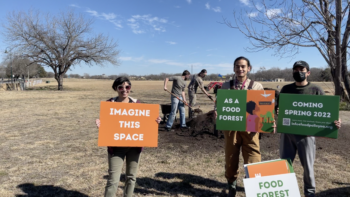
Before planting the Tamōx Talōm Food Forest in San Antonio, Texas, volunteers gathered community input through listening sessions, potluck gatherings, and signs that had a QR code linking to a survey. Photo: Katherine Favor
There are therapeutic activities, as well, that can be offered in the setting of urban agroforestry systems. “Nature and Forest Immersion,” also referred to as “forest bathing,” is one experience that urban agroforestry sites can offer. It involves engaging all the senses to reap mental, physical, emotional, and spiritual benefits, while more deeply connecting and creating a relationship with the surrounding natural world. Conservation Conexions, founded by Dr. Tamberly Conway, is one example of a group that offers guided forest immersion experiences in urban contexts. Its process involves guiding participants through a series of invitations, slowing down to the rhythm of nature, opening the senses, grounding the body, and fostering connection with the surrounding urban forest or any nearby nature in a transformative way. Forest immersion has been shown to provide quantifiable health and wellbeing to participants and is a relatively simple activity that can be implemented in any urban greenspace while also inspiring a connectedness with the natural world and fostering a conservation ethic. Other ideas for therapeutic activities that urban agroforestry sites can provide include nature journaling activities, forest art therapy, and forest yoga, among others.
There is no limit to the types of educational, therapeutic, and recreational activities to be created at an urban agroforestry site. In addition to being educational in nature, these activities can be fun and can strengthen community relationships.
Challenges
While there are many benefits to involving the public in a community agroforestry project, there can also be challenges. For instance, unfenced urban agroforestry systems that are open to the public may experience vandalism or property damage. A first instinct might be to install fences and cameras to avoid this kind of damage, but in the case of many public forest gardens, community accessibility is a core tenet. A different way to address vandalism that doesn’t involve exclusion might be to cultivate a sense of collective ownership and pride in the urban forest garden. Several public agroforestry site managers have noted that as communities grow to see public forest gardens as something that they are a part of and can access, instances of vandalism become less common. There are other types of unintentional damage that can occur as a result of involving community members, as well. Sometimes even the most well-meaning volunteers or visitors can cause damage by pruning incorrectly, weeding the wrong thing, trampling plants, or mulching over plants. However, mistakes are part of the learning process, and the benefits of involving the community in a forest garden project far outweigh the challenges.
Agroforestry in Schools
Agroforestry is increasingly being incorporated into school settings, often in the form of forest gardens. Forest gardens in schools can serve as places for children to engage with the natural world, promoting food and nature literacy by offering students a chance to play in nature, sample healthy foods, forge valuable relationships with one another, and learn different school subjects in an outdoor classroom setting. School gardens in general have been suggested by researchers to be powerful ways to teach about natural cycles, and forest gardens, with their high levels of biodiversity, offer a unique opportunity for students to learn about ecosystem function and the interconnectedness of life. By providing a platform through which students can participate in the food production process themselves, gardens have been shown to cultivate a sense of responsibility and a stewardship ethic in students. For example, one group of students managing a school garden in Berkeley, California showed improved grades, a better understanding of garden cycles, and more diverse diets after participating in school garden curriculum (Peloso, 2007). The Miami-Dade County Public School District has long recognized the benefits of forest gardens and has established them in 28 of its 51 schools. Students regularly use these forest gardens as outdoor classrooms and learning labs, and they also benefit by taking home produce, which helps supplement their diets with healthy and nutritious foods.
Conclusion
Urban agroforestry is a practical and useful approach for addressing some of the most pressing challenges that cities contend with today. Intentionally integrating trees into urban landscapes can provide numerous benefits to the environment, to individuals, and to communities as a whole. There is no single format that urban agroforestry systems must take, but the design principles behind well-known agroforestry practices such as windbreaks, alley cropping, silvopasture, riparian forest buffers, forest farms, and forest gardens can be drawn upon and woven together to create designs for urban agroforestry systems that address participants’ particular goals, resources, and growing contexts. With proper planning, design, maintenance, and decision-making structures, urban agroforestry sites can serve as valuable community assets that increase the sustainability and resilience of cities.
References
Albrecht, S., and A. Wiek. 2021. Food forests: Their services and sustainability. Journal of Agriculture, Food Systems, and Community Development. Vol. 1. p. 91-105.
Bukowski, C., J. Munsell, and L. Joy. 2018. The Community food forest handbook: How to plan, organize, and nurture edible gathering places. Chelsea Green Publishing. White River Junction, VT.
The Center for Agroforestry. 2023. University of Missouri.
Clark, K.H., and K.A. Nicholas. 2013. Introducing urban food forestry: a multifunctional approach to increase food security and provide ecosystem services. Landscape Ecology. Vol. 28. p. 1649–1669.
Egerer, M., H. Liere, A. Lucatero, and S.M. Philpott. 2020. Plant damage in urban agroecosystems varies with local and landscape factors. Agroecosystems. 1:e03074.
Lovell, S. 2010. Multifunctional urban agriculture for sustainable land use planning in the United States. Sustainability. Vol. 2. p. 2499-2522.
Lovell, S. 2020. Urban agroforestry and its potential integration into city planning efforts. Urban Agriculture and Regional Food Systems. May 19.
McLain, R.J., M.R. Poe, L.S. Urgenson, D.J. Blahna, and L.P. Buttolph. 2017. Urban non-timber forest products stewardship practices among foragers in Seattle, Washington, U.S.A. Urban Forestry & Urban Greening. Vol. 28. p. 36-42.
Peloso, J. 2007. Environmental justice education: Empowering students to become environmental citizens. Penn GSE Perspectives on Urban Education. Vol. 5, No. 1.
Romanova, O., and S. Lovell. 2021. Food safety considerations of urban agroforestry systems grown in contaminated environments. Urban Agriculture and Regional Food Systems.
Seserman, D.M., M. Veste, D. Freese, A. Swieter, and M. Langhof. 2018. Benefits of Agroforestry Systems for Land Equivalent Ratio – Case Studies in Brandenburg and Lower Saxony, Germany. 4th European Agroforestry Conference—Agroforestry as a Sustainable Land Use, Nijmegen, The Netherlands, 28-30 May.
Turner-Skoff, J., and N. Cavender. 2019. The benefits of trees for livable and sustainable communities. Plants, People, Planet. Vol. 1. p. 323-335.
US Environmental Protection Agency. 2019. Brownfields.
USDA National Agroforestry Center. 2022. Agroforestry Practices.
Further Resources
ATTRA Resources
Agroforestry: An Overview
This publication offers an introduction to the concept of agroforestry and its key practices: alley cropping, silvopasture, windbreaks, forest farming, and riparian buffer strips.
Building Sustainable Farms, Ranches, and Communities: Federal Programs for Sustainable Agriculture, Forestry Entrepreneurship, Conservation, and Community Development
A guide addressing federal program resources in community development, sustainable land management, and value-added and diversified agriculture and forestry.
Community Forest Gardens: Case Studies Across the United States
A collection of case studies of forest gardens and food forests in regions across the country, including lists of the plants they feature in each of eight vertical layers.
Community Gardening
A publication intended for organizations supporting community-gardening development, with information on starting community gardens and resources for establishing and managing them.
Community Supported Agriculture
A publication on the Community Supported Agriculture (CSA) model of selling produce, which connects people with where their food comes from by encouraging customers to become shareholders in the farm business.
Episode 240. Urban Agroforestry for Dryland Environments
A podcast episode from Voices from the Field, in which NCAT Agriculture Specialist Katherine Favor talks with Christopher Marciello of Ecology Artisans — a regenerative landscape and design firm —about urban agroforestry in dryland environments.
Farmscaping to Enhance Biological Control
This publication contains information about increasing and managing biodiversity on a farm to favor beneficial organisms, with emphasis on beneficial insects.
Forest Gardens Technical Guide (coming soon)
A technical guide for designing forest gardens/food forests, with information on planning, ecological design, management and maintenance, social considerations, and case studies.
Multiple Layers of a South Texas Food Forest
A video tour of the food forest at Keepers of the Garden, an urban agroforestry farm in Corpus Christi, Texas. This urban agroforestry farm is located in the Southern Subhumid Gulf Coastal Prairies ecoregion, in hardiness zone 9b, and it serves not only as a production farm but also as an educational center for schools, a refuge for local wildlife, and a community hub.
Regenerating Damaged Soils on an Urban Farm
A video demonstrating how Garcia Street Farm, an urban farm in San Antonio, Texas, is contending with issues such as compacted soil, debris, low organic matter, stubborn grass weeds from surrounding lawns, and lack of biodiversity for insect control.
Start a Farm in the City
A pictorial guide to planning and launching an urban farm.
Urban Agroforestry Case Study: Utilizing Agroforestry in Floodplain Restoration Projects
The story of how the City of Austin, Texas, is using urban agroforestry to restore floodplain-buyout land that previously had residential housing on it.
Urban Agroforestry Case Study: Starting a Food Forest on Public Park Land
Festival Beach Food Forest’s story of starting a community food forest on public park land in Austin, Texas.
Urban Agroforestry Tipsheet: Food Forests and Beyond
Information about agroforestry in urban areas, including tips for how to plan, design, establish, and maintain urban agroforestry systems.
Other Resources
Association of Nature and Forest Therapy (ANFT)
One of the leaders in promoting the development and practice of Forest Therapy, a program that draws on the latest medical research, new developments in the field of nature connection, and ancient traditions.
Building Our Future: A Guide to Community Visioning. 2000. By Gary Green, Anna Haines, and Stephen Halebsky. Cooperative Extension of the University of Wisconsin–Extension.
A manual that provides community residents with a process for thinking about and planning for their mutual future.
The Center for Agroforestry at the University of Missouri
The Center for Agroforestry is one of the world’s leading centers contributing to the science of agroforestry. The Center’s long-term research, teaching, and technology-transfer efforts help make a better world by discovering, integrating, and applying new agroforestry knowledge, and by educating and training students, professionals, scientists, leaders, and the general public.
Community Food Forests
An interactive map of community food forest initiatives across the United States.
The Community Food Forest Handbook. 2018. By Catherine Bukowski and John Munsell. Chelsea Green Publishing Co., White River Junction, VT.
A book about the civic aspects of community food forests, with ideas for building and sustaining momentum, working with diverse stakeholders, integrating assorted civic interests and visions within a project, creating safe and attractive sites, navigating community policies, and more.
Creating a Forest Garden—Working with Nature to Grow Edible Crops. 2010. By Martin Crawford. Green Books, UK.
Information on forest gardens, including planning, design, planting, and maintenance, as well as a detailed directory of more than 500 edible plants.
Edible Forest Gardens, Vol. 1. 2005. By Dave Jacke and Eric Toensmeier. Ecological Vision and Theory for Temperate Climate Permaculture. Chelsea Green Publishing Co., White River Junction, VT.
Introduces historic and visionary bases of edible forest gardens. It describes ecological relationships, structures, and succession.
Edible Forest Gardens, Vol. 2. 2005. By Dave Jacke and Eric Toensmeier. Ecological Design and Practice for Temperate Climate Permaculture. Chelsea Green Publishing Co., White River Junction, VT.
Details the design process, site preparation, establishment, and maintenance of the edible forest garden.
Forest Gardening: Cultivating an Edible Landscape, 2nd Edition. 1996. By Robert Hart. Chelsea Green Publishing Co., White River Junction, VT.
Describes how to transform even a small cottage garden into a hospitable diverse habitat for songbirds, butterflies, and other wildlife by using a wide variety of useful plants.
Gaia’s Garden: A Guide to Home-Scale Permaculture, 2nd Edition. 2009. By Toby Hemenway. Chelsea Green Publishing Co., White River Junction, VT.
A guide to creating a backyard ecosystem by assembling communities of plants that can work cooperatively, with a chapter on urban permaculture.
An Introduction to Agroforestry. 1993. By P.K. Nair. Springer Dordrecht. Dordrecht, Netherlands.
A comprehensive introduction to the principles and applications of agroforestry in various parts of the world.
North American Agroforestry: An Integrated Science and Practice. 2nd Edition. 2009. Edited by H.E. Garrett. American Society of Agronomy, WI.
Covers the fundamentals of the main agroforestry practices, with detailed case studies and examples, as well as strategies for addressing the financial aspects of the practices.
Perennial Pathways: Planting Tree Crops. Designing & Installing Farm-Scale Edible Agroforestry. Savanna Institute. Champaign, IL.
A comprehensive guidebook for designing and installing farm-scale edible agroforestry.
Resources for Working with Communities. 2020. By Catherine Bukowski.
Resources for creating systems of governance and decision making, leading productive meetings, community visioning, and more.
Stormwater to Street Trees: Engineering Urban Forests for Stormwater Management. 2013. By U.S. Environmental Protection Agency Office of Wetlands, Oceans and Watersheds. Washington, DC.
A guide to the ways that trees can increase the effectiveness of grey and green stormwater systems in urban areas.
USDA NRCS PLANTS Database
An extensive plant database for determining species for agroforestry operations based on different criteria.
Urban Agroforestry
By Katherine Favor, NCAT Agroforestry Specialist, and Justin Morris, NCAT Sustainable Agriculture Specialist
Published September 2023
© NCAT
IP395
This publication is produced by the National Center for Appropriate Technology through the ATTRA Sustainable Agriculture program, under a cooperative agreement with USDA Rural Development. This publication was also made possible in part by a cooperative agreement with the United States Botanic Garden, and by a grant from the U.S. Department of Agriculture (USDA), Forest Service, National Agroforestry Center, under the authority of the Cooperative Forestry Assistance Act of 1978. These institutions are equal opportunity providers, employers, and lenders. ATTRA.NCAT.ORG.


